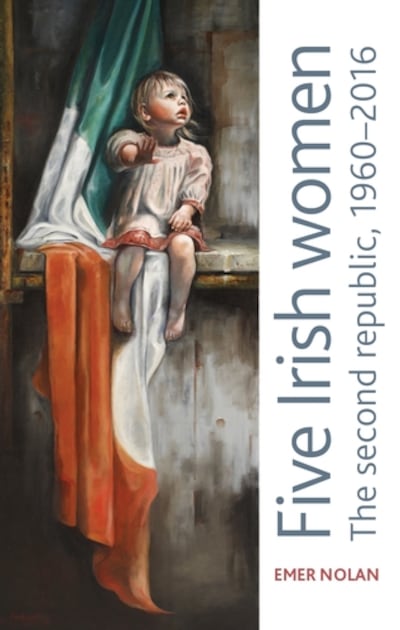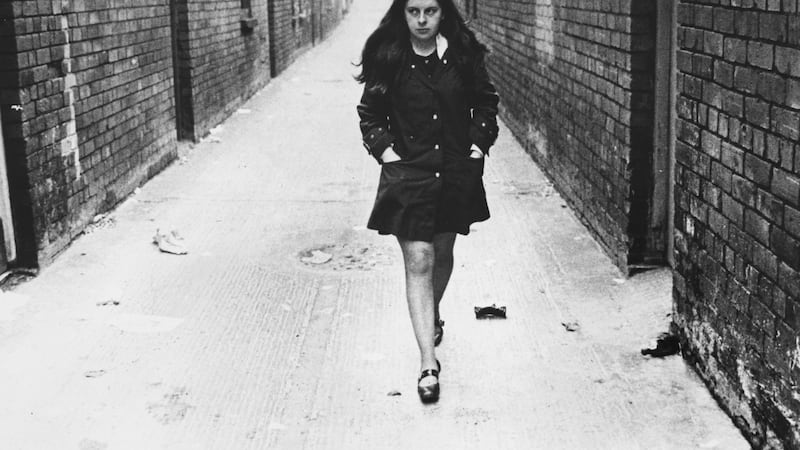In her memoir Country Girl (2013), Edna O’Brien recalls her first sight of O’Connell Street when she, a young provincial, arrived in Dublin from Clare:
“Opposite [Nelson’s] pillar was the General Post Office, where the men of the 1916 rebellion proclaimed the Irish Constitution, raised the Irish flag, but were soon overwhelmed and summarily executed in Kilmainham Yard. Further along, a statue of Daniel O’Connell, the Catholic emancipator, an iron man in a black iron coat with iron angels guarding him. But I was finished with all that, with history and martyrs and fields … being, as I believed, on the brink of daring emancipation.”

Dublin, the country girl hoped, was to be a liberation.
Forty years later, in 1990, on her election as President, Mary Robinson too associated the freedom of Irish women with a willingness to transcend earlier conflicts that had defined Mother Ireland. In Dublin Castle, of all places, she famously hailed Mná na hÉireann who, by choosing a feminist candidate, had rocked the system not the cradle. Irish people, she announced, had “stepped out from the faded flags of the Civil War and voted for a new Ireland”.
But was it ever that simple? Certainly, for O’Brien, even her eventual departure from Ireland was no goodbye to all that. In The Girl with Green Eyes (1962), the second of The Country Girls novels that made her reputation, a distraught Caithleen Brady, while fleeing from an abusive husband in London, imagines at Waterloo station that she hears a voice speaking in a rich Irish country accent and there, on the platform, “a gray cloth map on the school wall, long forgotten, rose before her eyes, a map with names that were once names and now which had the intrigue of legend – Coleraine, Ballinasloe, and Athy”.
Relationships, usually with exotic European men, invariably disappoint O’Brien’s characters, but the romance with Ireland endures.
Encountered repeatedly in her fiction is the girl who has been encouraged to identify herself with the national territory and who then, as a woman, successfully internalises – even embraces – such an apparently stereotypical identification. O’Brien herself made no bones about it: “Irish? In truth I would not want to be anything else. It is a state of mind as well as an actual country. It is being at odds with other nationalities, having quite different philosophy about pleasure, about punishment, about life, and about death having quite different philosophy about pleasure, about punishment, about life, and about death”.
Crucially, that “state” has never been just one of suffering. Notions of the ‘wild Irish girl’, from the warrior queen Grace O’Malley down to the red-haired Hollywood colleen, still endure. Indeed, that O’Brien herself had survived scandal and censorship in Ireland only enhanced her reputation – at home and abroad. And, in this regard, she typifies how internationally celebrated Irish women have conjured up a mix of both traditional and modern images, of victims and rebels, in their appearance and voices.

One avowed rebel, Bernadette Devlin (later McAliskey) broke radically with conventional styles of protest in Northern Ireland. The outstanding speech-maker of the Civil Rights campaign, she was dubbed St Bernadette of the Barricades for her role in organizing the defence of Catholic areas of Derry in August 1969. Some likened her to Joan of Arc. But she was having none of it. In an extraordinary maiden speech at Westminster, to which she was elected at the age of 21, she declared that she stood, not with any group defined by religion, but with the poor of Ireland – the “peasants” and the “have-nots”.
Still, this “Fidel Castro in a mini-skirt” retained a degree of ambivalence towards traditional allegories of the nation. Among the women activists interviewed for Anne Crilly’s 1988 documentary film, Mother Ireland – banned from UK television because it included an interview with an IRA member Mairéad Farrell, McAliskey stands out for her refusal to reject outright the idea of Ireland as a mother: “For all her strengths and weaknesses and areas of reaction and all the problems she has caused me, I would still very much see myself as a child of Mother Ireland”.
Irish radical women have long argued about feminism and Irish politics. The revolutionary Constance Markievicz declared in 1909 that her allegiances were evenly divided: “No one should place sex before nationality or nationality before sex”. In 1980, journalist and activist Nell McCafferty wrote about women’s prison protests in the North for The Irish Times; an article entitled “It is my belief that Armagh is a feminist issue” opened with the sentence: “There is menstrual blood on the walls of Armagh prison in Northern Ireland”. But was this a feminist protest? Many southern feminists believed that the women in Armagh were as much victims of republican ideology as of British imperialism.
For McAliskey, being a mother in a beleaguered community was not a passive or romantic role. Home was an enclave to be protected. Fathers were often absent, imprisoned or dead. After decades of conflict, masculine authority was in any case discredited and tainted by the misbehaviour of soldiers, priests and politicians. McAliskey’s recreation of the stereotype as an image of resistance in Mother Ireland is a feminist act.

Sinéad O’Connor released her debut album, The Lion and the Cobra, in 1987, a year before the banning of Mother Ireland. That album and the follow-up, I Do Not Want What I Have Not Got (1990), won her huge fame. Her attitudes towards Ireland, Catholicism and the music business were at odds with many aspects of the upbeat, commercialised Irishness then prevalent in popular culture. There was an incongruity between the modish, minimalist, shaved-headed young woman and her preoccupation with the pain of loss – raw, recent and personal, deep, distant and communal - and the aural expression of that pain in a voice as folk as punk.
No less than O’Brien, O’Connor was pivotal in searing into the public mind the image of the woman and the child as the great victims of independent Ireland. Female artists, in particular, had remade the received idea of the nation.

Notwithstanding her extensive and sometimes despairing attention to the effects of misogyny, sectarianism and economic inequality in the country, the late Nuala O’Faolain, in her journalism, fiction and memoirs, testified to her ongoing emotional and political involvement with Ireland. She constantly scrutinised these feelings and affiliations. “It’s a bit embarrassing to say so”, she wrote in her best-selling 1996 memoir, Are You Somebody?, “but there is such a thing as loving Ireland. There are good reasons for sticking it out in this damp little shambles of a democracy on the edge of the Western world … In the past year, on television, I’ve seen the faces of two men – Peadar O’Donnell and Noel Browne – who led noble lives here. For as long as Ireland can solicit such lives, it can certainly solicit mine.”
In her now-famous memoir, O’Faolain described how she escaped isolation and despair in England by returning to Ireland to take up a job in RTÉ. She then experienced an entirely new sense of belonging to the country. She discovered her “intemperate love for the fabric of Ireland’”, as well as for the few streets she already knew well in the middle of Dublin.
At the end of her book, she finds an image of her life up to that point in the west of Ireland. In its very brokenness and discontinuity, the landscape was like a record of her own experience:
“Behind me, up in the Burren, nothing knitted together. There’s a pre-historic burial site. There’s a village abandoned in the Famine. There’s a tiny twelfth-century church. There’s a holy well. There’s a mound of shells near a cooking-pit. Each thing is itself, discrete. Near each other, and made from the same material, but never flowing into each other. That’s how the life I have described here has been. There has been no steady accumulation: it has all been in moments.”
In 2007, O’Faolain angrily predicted an “all-island Ireland, united by utter, unashamed, consumer capitalism. There’ll be 32 green fields full of shopping centres.” Over a decade later, the prospect of Irish unity is now discussed more urgently than it was then. But what kind of reunification?
Feminism is about the emergence of what Simone de Beauvoir calls the independent woman, one who can pursue her own desires and her own work. Life in Ireland for “independent women” – or at least privileged ones – is surely vastly easier now than it was for these pioneering figures. But these Irish women looked beyond individualistic solutions to the difficulties of their situations.
Women are often aware of themselves having been (or of still being) defined as the “other” – as Beauvoir puts it – of mainstream culture. As such, they are particularly alert to the repressive effects of collective identities, including that of the nation, which are so often dominated by the interests of men. But neither do these women uncritically accept the promises of postmodern, capitalist consumerism to dissolve history and erase the specificity of place. This is despite the fact that several of these women seemed at one time to be icons of a glamorous modernity in Ireland – fluent in a new language of feeling, at home in a world of new pleasures.
For O’Faolain, Irishness, understood as an historically-determined condition, was a storehouse of melancholy, beauty and meaning that had survived the fetishisation of a certain version of Catholic tradition in the Ireland presided over by Éamon de Valera. It was associated with forms of community that were for her less claustrophobic than the patriarchal family and less isolating than the addictive excitements of romantic love.
Despite what was for most of these women their difficult formations and often cruel suffering in the country, Ireland remained in their work a sublime object of affection, repudiation and commitment.
Emer Nolan is the author of Five Irish Women: The Second Republic, 1960–2016 (Manchester University Press, £80, September 2019)






















